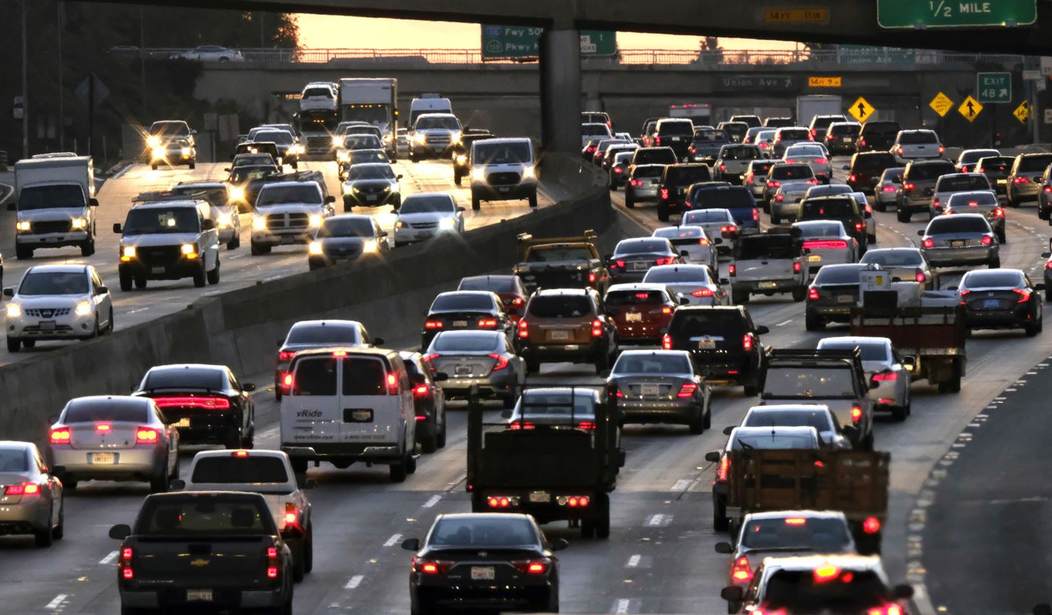In this episode of The No-Longer-Golden State of California…
It’s “almost” like California Democrat Gov. Gavin Newsom is trying to drive out — literally — the remaining sane people of the beautiful yet whacked-out state. And for non-Californians, that’s not the worst of it.
California regulators, on Thursday, will vote to put in place a sweeping plan to restrict and ultimately ban the sale of gas-powered cars, a move that Newsom described as the beginning of the end for the internal combustion engine, as reported by the New York Times. To put the “green” insanity into perspective, only 12 percent of passenger vehicles currently sold in California are electric-powered vehicles. (EVs)
Even worse — for tens of millions of American fortunate not to live in California — the ban, scheduled to take effect by 2035, will likely speed a wider transition to electric vehicles as multiple states are expected to follow the lead and pass similar bans. Given that 12 states already follow California’s emission “standards,” if just those 12 states follow the ban — and most if not all are expected to, per The Times — gas-powered passenger vehicles would likely be banned in about a third of the U.S. auto market.
Margo Oge, an electric vehicles expert who headed the Environmental Protection Agency’s transportation emissions program under Presidents Bill Clinton, George W. Bush, and Barack Obama, called the ban “huge,” per The Times.
This is huge. They will drive the market, and drive innovation.
Sure it will. And if current average price differences between EVs and similarly-based gas-powered cars continue, it will also drive untold numbers of Americans into financial distress.
John Bozzella, president of the Alliance for Automotive Innovation told The Times that California’s goal will be “extremely challenging.”:
Whether or not these requirements are realistic or achievable is directly linked to external factors like inflation, charging and fuel infrastructure, supply chains, labor, critical mineral availability and pricing, and the ongoing semiconductor shortage.
Obviously, Mr. Bozzella is unfairly resorting to facts, data, logic, and common sense — a no-no when debating left-wing insanity. [sarcasm, of course] To Bozzella’s point, EVs aren’t nearly as “green” as climate alarmists think.
As reported by Foundation for Economic Education, carbon emissions “don’t just come out a tailpipe.” EVs emit CO2 both in their production and during charging. The production of electric batteries requires lithium, cobalt, and manganese. A tremendous amount of fossil fuel-generated energy is spent on mining and processing these raw materials.
Here’s more from FEE:
According to a new German study … “for a Tesla battery of 75 kWh, this means an additional CO2 emission of 10 875 kg to 14 625 kg of CO2.” Converted to pounds, these numbers are between 23 thousand and 32 thousand pounds of carbon emissions. For each battery!
Even after the initial production of the battery, many electric cars are charged by power plants that produce electricity by burning coal or gas. According to the US Energy Information Administration, 63 percent of total electricity generation in the United States is created using fossil fuels. If the electricity being used to power the electric cars is being produced using fossil fuels, then using electric cars is simply shifting CO2 emissions from the tailpipe of the car to the electricity power plant.
“Green” energy alarmists like Pete Buttigieg, John Kerry, and Joe Biden “forget” facts like the above while singing utopian praises of electric vehicles. As the Democrats’ incessant attacks on fossil fuels and glowing praise of EVS continues, FinanceBuzz in June dropped an article titled, 10 Hidden Costs of Owning an Electric Vehicle. The list includes:
Higher purchase price: According to Kelley Blue Book, the average price of an EV was $56,437 in November 2021. That’s about $10,000 more than the $46,329 industry average for both gas and electric vehicles. Reasons for the higher prices include increased demand and the extra technology involved in an EV.
Charging on the road: You may see your electric bill go up after you get an EV and start charging it at home. But the real surprise could be when you try to charge up on the road. Prices for public charging stations vary widely by provider. Additionally, some states allow pricing based on the kWh of electricity used, while others only let providers charge on a per-minute basis.
Battery replacement: Many EV drivers may experience range anxiety worrying that they may not have enough charge to get where they want to go. The good news is that battery technology is improving, allowing drivers to get farther on one charge. However, you’ll likely need to replace your EV battery every eight years or 100,000 miles. While this seems a long way off, you could end up spending anywhere from $5,600 and $20,000 to have your battery replaced.
Higher repair costs: Repair costs could end up costing you more money since some repairs are usually more expensive on an electric car than on a gas-powered vehicle. […] A scarcity of parts can also drive up prices when it comes to replacing parts. There could also be an issue with who can repair your vehicle. Electric vehicle auto mechanics may not be as easy to find as combustion engine mechanics. Your car manufacturer may also have restrictions on who can repair your particular type of vehicle.
Charging time: Time is money, and while it may not be a tangible cost, it’s something to consider as you think about getting an EV. While a fast charger can fully charge your EV in less than 30 minutes, that’s still a lot longer than it takes to fill a traditional car at the pump. If you’re not using a fast charger, that time can increase to seven, eight, or even 12 hours.
Yet, clueless Newsom? He said in a recent interview, as transcribed by The Times:
Our kids are going to act like it’s a rotary phone or changing the channel on a television.
Sure they will. Given Newsom’s hypocritical violations of his own draconian COVID mandates, I’m sure he’ll have a sweet red Ferrari stashed away, somewhere. Either way, I’m pretty sure Gavin will have no worries.
The bottom line:
I’m not suggesting, as do some, that electric vehicles are foolhardy or impractical for everyone, and not a wise choice for some. I’ve driven a Tesla Model S — fast — and as a lifelong car guy, in my not-so-humble opinion, it’s a damn sweet car. That said, the current starting price of a 2022 Model S is $109,490.
What I am saying is the government (federal, state, or any otherwise) banning gas-powered vehicles because climate alarmists trot out silly phrases like “the existential threat to mankind,” while many of them (See: John Kerry and Leonardo DiCaprio) jet around the world in their private jets and sail the seas aboard their private yachts (all powered by fossil fuels), is anathema to capitalism and free markets.
Those who choose to purchase EVs have every right to do so. Those who don’t should not be forced to.














Join the conversation as a VIP Member